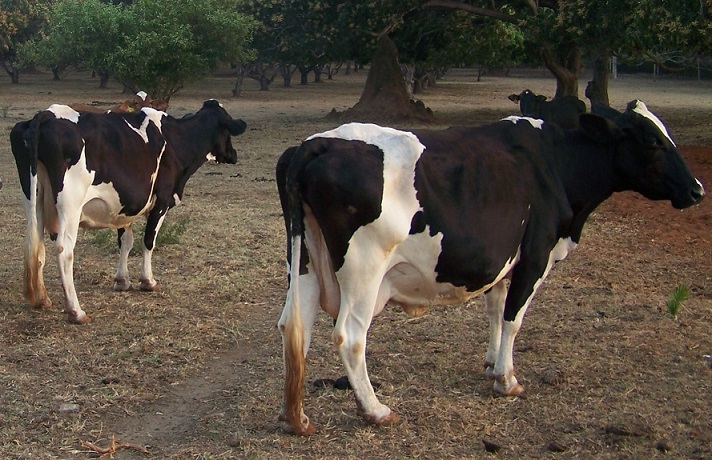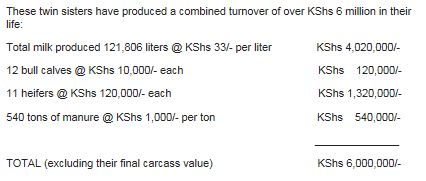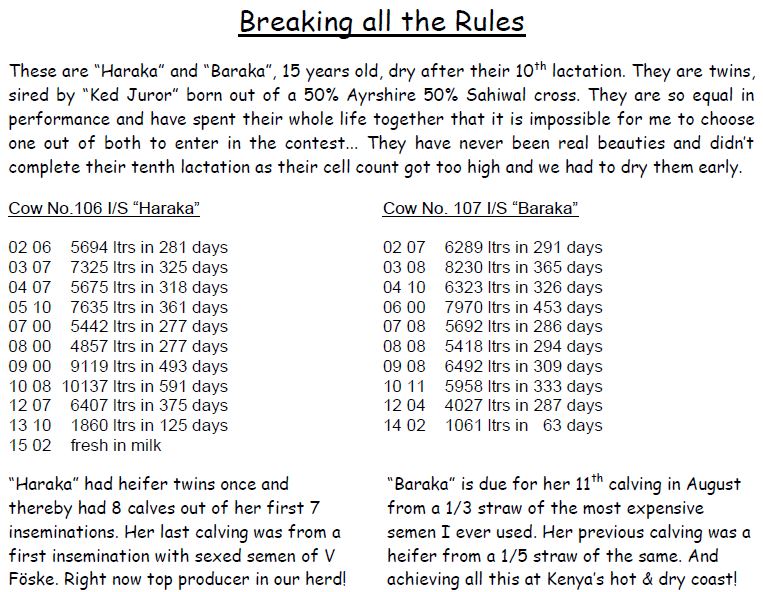Cows that make Millions...

All these are calculated at present day values and under the assumption that you have managed to sell all their produce at above indicated prices. Actually these cows are capable of producing above output under quite unfavorable conditions, in areas of Kenya where farm gate price of milk is much higher than KShs 33/- per liter.
What is the secret of their success and this incredible performance?
The most frequently asked question which I have encountered in the last 25 years of dairying is that of “What is the best breed of dairy cow in Kenya”? I have extensively dealt with this question in “The Most Profitable Dairy Cow”, but to summarize this long and quite scientific article into a single sentence: Have at least 25% of Bos Indicus (high quality Sahiwal, Red Sindhi, Gir or Guzerat) in your cow’s genetic makeup. This is the fundamental idea behind the MAGIC breed development project.
A Portrait of true Champions:
“Haraka” and “Baraka” have never won a ribbon or trophy in any of Kenya’s Agricultural Shows, they have no official pedigree and they are not recognized by either the Kenyan Studbook or any of Kenya’s Cattle Breed Associations. When their full brother was offered to CAIS for semen collection 13 years ago, the idea was so outrageous and digressive that it was not even considered worth a reply. Nonetheless they are cows who have given a lifetime of faithful service to their owner and a type of cow every commercial dairy farmer should aspire to acquire. And if wondering which kind of cow will most likely be able to see your kids through school? Well, I most definitely wouldn’t bet my money on that Show winning Pedigree Studbook cow, possibly even imported from abroad.

This is Haraka’s and Baraka’s nomination for the “Best Crossbred Cow of the year Competition”, you are welcome to join and give your vote to the most deserving candidate in: http://www.dairyxbred.com/
How or where can you get such a cow?
a) There are a number of farms in Kenya selling commercial in-calf-heifers with varying Bos Indicus ingredient at quite reasonable prices:
-
Some ADC farms for example ADC Kiswani Complex in Malindi
-
Kilifi Plantations LTD
-
Mianje Dairy Farm, South coast
-
Some farms in Rift Valley region who are breeding Boran*Holstein
-
A farm in Nyanza region who is breeding Boran/Sahiwal*Red Poll
Sorry I don’t have the names and details for all the Up-Country farms, your inputs would be greatly appreciated here…
If the Bos Indicus ingredient is derived from Boran (which is not really suitable for high milk production) it should definitely not be more than 25%!
b) A cheaper and more effective method, although taking much longer, is what was done in the case of Haraka and Baraka, breed them yourself:
-
If you start with a High Grade European breed cow use purebred Bos Indicus semen (Sahiwal, Red Sindhi, Gir or Guzerat) on her and then inseminate the resulting female offspring with European Breed (Bos Taurus) semen. In Kenya so far only Sahiwal semen was readily available as the Bos Indicus ingredient.
-
If you start with a Zebu cow, like a Boran, Small East African Zebu or Sahiwal then use high quality Bos Taurus semen on her and again on all her female offspring
-
If you want to see results faster and skip one generation then use MAGIC50 semen or a 50% Bos Indicus crossbred bull (Preferably Sahiwal or Gir) on your European breed cows (not heifers!). Very limited amounts of this semen can now be obtained from KAGRC. If a 50% Bos Indicus sire can’t be obtained even one with a lesser percentage will still produce remarkable results.
Last but not Least…
Before you rush out to the bank to secure a loan for the purchase of such a fabulous cow please note that all above calculations are strictly turnover and not the profit that will remain after deducting all the expenses you will incur when properly taking care of your cow. And to be able to produce these quantities of milk and to live for such a long time, she will really need good care! To give you a more realistic and feasible approach you must absolutely read “Profits” and “100-days-test”, please!





